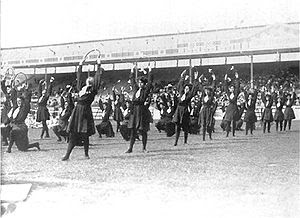


Malaysia Sports

Gymnastics is an activity and sport involving performance of exercises requiring physical strength, flexibility, agility, co-ordination, balance, and grace. Internationally, all of the gymnastic sports are governed by the Fédération Internationale de Gymnastique (FIG) with each country having its own national governing body affiliated to FIG. Competitive Artistic gymnastics is the best known of the gymnastic sports. It typically involves the women's events of uneven parallel bars, balance beam, floor exercise, and vault. Men's events include floor exercise, pommel horse, still rings, vault, parallel bars, and high bar. Gymnastics evolved from exercises used by the ancient Greeks, that included skills for mounting and dismounting a horse, and from circus performance skills.
Other gymnastic sports include rhythmic gymnastics, the various trampolining sports, and aerobic and acrobatic gymnastics.
Participants can include children as young as two years old and sometimes younger doing kindergym and children's gymnastics, recreational gymnasts of all ages, competitive gymnasts at varying levels of skill, as well as world class athletes.
HISTORY
To the Ancient Greeks, physical fitness was paramount, and all Greek cities had a gymnasium, a courtyard for jumping, running, and wrestling. As the Roman Empire ascended, Greek gymnastics gave way to military training. The Romans, for example, introduced the wooden horse. In 393 AD the Emperor Theodosius abolished the Olympic Games, which by then had become corrupt, and gymnastics, along with other sports, declined. For centuries, gymnastics was all but forgotten.
In the fifteenth century, Girolamo Mercuriale fromForlì (Italy) wrote De Arte Gymnastica, that brought together his study of the attitudes of the ancients toward diet, exercise and hygiene, and the use of natural methods for the cure of disease. De Arte Gymnastica also explained the principles of physical therapy and is considered the first book on sports medicine.
In the late eighteenth and early nineteenth centuries, two pioneer physical educators – Johann Friedrich GutsMuths (1759–1839) and Friedrich Ludwig Jahn (1778–1852) – created exercises for boys and young men on apparatus they had designed and that ultimately led to what is considered modern gymnastics. In particular, Jahn crafted early models of the horizontal bar, the parallel bars (from a horizontal ladder with the rungs removed), and the vaulting horse.
The International Federation of Gymnastics (FIG) was founded in Liege in 1881. By the end of the nineteenth century, men's gymnastics competition was popular enough to be included in the first "modern" Olympic Games in 1896. From then on until the early 1950s, both national and international competitions involved a changing variety of exercises gathered under the rubric gymnastics that would seem strange to today's audiences: synchronized team floor calisthenics, rope climbing, high jumping, running,horizontal ladder, etc. During the 1920s, women organized and participated in gymnastics events, and the first women's Olympic competition – primitive, for it involved only synchronized calisthenics – was held at the 1928 Games in Amsterdam.
By 1954, Olympic Games apparatus and events for both men and women had been standardized in modern format, and uniform grading structures (including a point system from 1 to 15) had been agreed upon. At this time, Soviet gymnasts astounded the world with highly disciplined and difficult performances, setting a precedent that continues. The new medium of television helped publicize and initiate a modern age of gymnastics. Both men's and women's gymnastics now attract considerable international interest, andexcellent gymnasts can be found on every continent. Nadia Comaneci received the first perfect score, at the 1976 Summer Olympics held in Montreal, Canada. She was coached in Romania by the Romanian coach, (Hungarian ethnicity), Béla Károlyi. According to Sports Illustrated, Comaneci scored four of her perfect tens on the uneven bars, two on the balance beam and one in the floor exercise. Even with Nadia's perfect scores, the Romanians lost the gold medal to the Soviets. Nevertheless, Comaneci became an Olympic icon.
In 2006, a new points system for Artistic gymnastics was put into play. With an A Score (or D score) being the difficulty score, which as of 2009 is based on the top 8 high scoring elements in a routine (excluding Vault). The B Score (or E Score), is the score for execution, and is given for how well the skills are performed.

FORMS
ARTISTIC GYMNASTICS

Gymnast o n uneven bar
The gymnast performs a choreographed routine up to 90 seconds in length consisting of leaps, acrobatic skills, somersaults, turns and dance elements on a padded, and sprung beam. The beam is 125 centimetres (4.1 ft) from the ground, 500 centimetres (16 ft) long, and 10 centimetres (3.9 in)wide.The event requires in pa rticular, balance, flexibility and strength.
Men's event
Floor exercise
Male gymnasts also perform on a 12m. by 12m. spring floor. A series of tumbling passes are performed to demonstrate flexibility, strength, and balance. The gymnast must also show strength skills, including circles, scales, and press handstands. Men's floor routines usually have four passes that will total between 60–70 seconds and are performed without music, unlike the women's event. Rules require that male gymnasts touch each corner of the floor at least once during their routine.
ALSO AVAILABLE IN:
TOKOH-TOKOH GIMNASTIK
Nur Hidayah Abdul Wahid
at the the World Championships in Japan
posted by Kumpulan Boonx2 on 3:22 AM

[web-design by may]
| ` Group Info |
 We are a small little group in 5Sc1, we work together for sivik project and there's caring and cooperating found around us while doing this project :) Our group consists of 5 people, the group name is taken from the only guy in our group, and the nickname we usually call him : BOONx2 We are ` Chua Boon Hao (Leader) ` Chong Jia Chee ` Heng Zhi Sam ` Ng Ke Chin ` Tew Xiaoxi |
| ` Contents |
|
Main Page Sepak Takraw Bicycle Racing Swimming Synchronized Swimming Gymnastics Squash Bowling Badminton Tennis Formula 1 |
| ` Shout! |
|
|
| ` Music |
|
|






